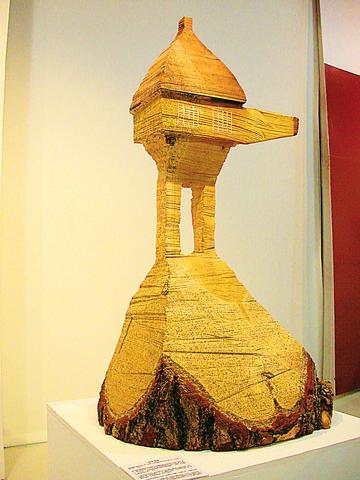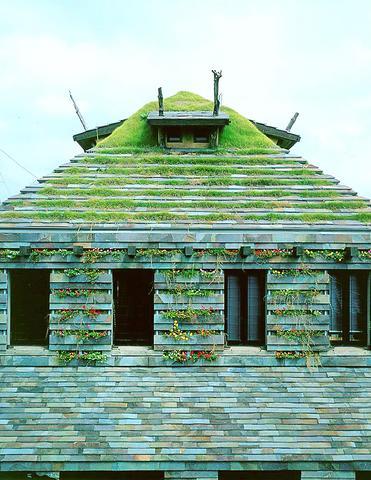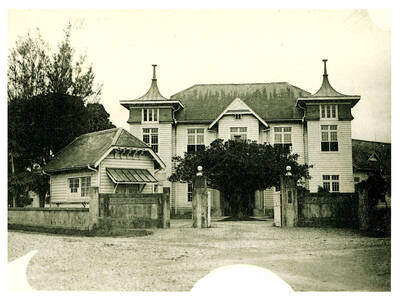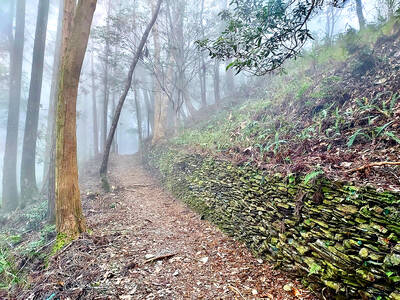My dream is to grow plants on buildings just as the human body grows hair," said Terunobu Fujimori, the architectural historian turned architect who grabbed Japanese media attention in the 1990s with a series of buildings that incorporated living plants.
The names of Fujimori's works -- Chive House, Dandelion House, Single Pine House -- pretty much say it all. Hundreds of pots of chives sway in the breeze on the slanting roof of a one-story cabin in Chive House while the roof of Single Pine House has a pine tree growing on it.

PHOTO:VICO LEE, TAIPEI TIMES
Photos of these and six other buildings by Fujimori in Japan, as well as four models of his architecture, are currently on show in Wildness in Architecture (野蠻建築展) at the National Culture Association (文化總會).

PHOTO COURTESY OF THE NATIONAL CULTURAL ASSOCIATION
For Fujimori, one of the key issues in 21st century civilization is the relationship between the natural and the manmade. His buildings, which incorporate nature, are meant to deal with the issue from a visual and aesthetic perspective.
In addition to his architecture, Fujimori is known for a series of award-winning essays collected in Adventures of Detective Architecture, published in the 1980s. It was the first series of architectural essays to become a national best-seller in Japan.
Convinced that artificial structures and elements in nature can reach a perfect harmony, Fujimori uses steel, mortar and industrial wood to build the inner structures and hidden elements of buildings while placing plants, soil and stone in the more visible locations.
The results are often houses of "ambiguous nationality" which appear naive or even surreal. He planted grass in a diagonal grid all over the roof of Camellia Castle, where a camellia is also planted.
"We often see plants on roofs of modern buildings, but they hardly ever blend in with the architecture. This is because rooftop gardens are usually designed by ecologists, who dislike artificial things. They would rather suppress the artificial to better express the plants," Fujimori said.
"But I think both the plants and the building have to look good. It's not easy, but I want them to get along well."
Apart from building private houses, Fujimori designed the Kumamoto Prefecture Agricultural University Student Dormitory using local timber. Independent pillars, a characteristic of Japanese wooden architecture, are used, but with a twist -- the rows of freestanding, undressed pine columns give people the illusion they're walking in a forest.
Fujimori admits that there are many limits to this incorporation of natural elements. "In Japan, most plants die in winter, so the houses can appear pretty only for a brief time. And when they grow too quickly, the house seems untidy. It takes a lot of work to make these buildings look nice," he said.
Plants in Taiwan, for example, may overwhelm the whole building into which they are integrated because they are "extremely strong".
Wildness in Architecture will show at the National Culture Association located at 15, Chungchin S Rd Sec 2 (

April 14 to April 20 In March 1947, Sising Katadrepan urged the government to drop the “high mountain people” (高山族) designation for Indigenous Taiwanese and refer to them as “Taiwan people” (台灣族). He considered the term derogatory, arguing that it made them sound like animals. The Taiwan Provincial Government agreed to stop using the term, stating that Indigenous Taiwanese suffered all sorts of discrimination and oppression under the Japanese and were forced to live in the mountains as outsiders to society. Now, under the new regime, they would be seen as equals, thus they should be henceforth

Last week, the the National Immigration Agency (NIA) told the legislature that more than 10,000 naturalized Taiwanese citizens from the People’s Republic of China (PRC) risked having their citizenship revoked if they failed to provide proof that they had renounced their Chinese household registration within the next three months. Renunciation is required under the Act Governing Relations Between the People of the Taiwan Area and the Mainland Area (臺灣地區與大陸地區人民關係條例), as amended in 2004, though it was only a legal requirement after 2000. Prior to that, it had been only an administrative requirement since the Nationality Act (國籍法) was established in

With over 80 works on display, this is Louise Bourgeois’ first solo show in Taiwan. Visitors are invited to traverse her world of love and hate, vengeance and acceptance, trauma and reconciliation. Dominating the entrance, the nine-foot-tall Crouching Spider (2003) greets visitors. The creature looms behind the glass facade, symbolic protector and gatekeeper to the intimate journey ahead. Bourgeois, best known for her giant spider sculptures, is one of the most influential artist of the twentieth century. Blending vulnerability and defiance through themes of sexuality, trauma and identity, her work reshaped the landscape of contemporary art with fearless honesty. “People are influenced by

The remains of this Japanese-era trail designed to protect the camphor industry make for a scenic day-hike, a fascinating overnight hike or a challenging multi-day adventure Maolin District (茂林) in Kaohsiung is well known for beautiful roadside scenery, waterfalls, the annual butterfly migration and indigenous culture. A lesser known but worthwhile destination here lies along the very top of the valley: the Liugui Security Path (六龜警備道). This relic of the Japanese era once isolated the Maolin valley from the outside world but now serves to draw tourists in. The path originally ran for about 50km, but not all of this trail is still easily walkable. The nicest section for a simple day hike is the heavily trafficked southern section above Maolin and Wanshan (萬山) villages. Remains of